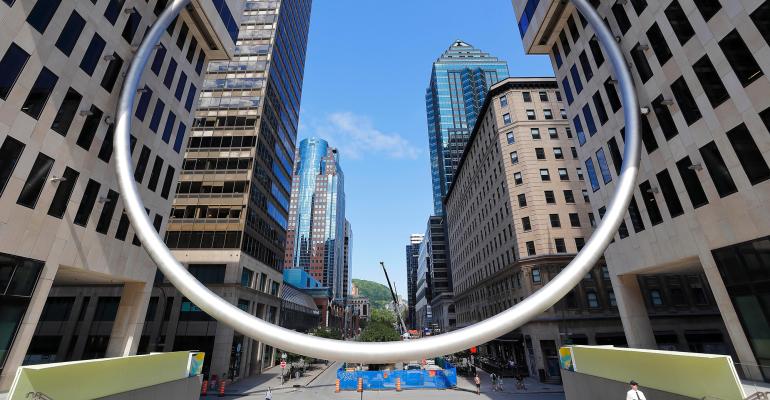(Bloomberg)—Montreal thrived for years as a bustling property market, tech-company hotspot and an artistic center, with new office and condo towers rising like never before to keep up with demand.
Now the downtown is marked by construction cones, quiet streets and empty buildings.
As much of the world barrels back to post-Covid normalcy, Canada’s second-largest city is struggling to recover. Its office vacancy rate has soared to 16%, according to CBRE Group Inc., with only Calgary faring worse among the nation’s five largest metropolitan areas. More supply is coming this year as National Bank of Canada opens a 40-story headquarters, Montreal’s tallest new building since the 1990s.
While flexible-work policies are reshaping downtowns around the world, Montreal has its own set of special circumstances. The province of Quebec forced residents to stay home longer than almost anywhere in North America — even imposing a curfew that lasted for months during the worst Covid times. Many workers just don’t want to go back to their old routine, a situation exacerbated by huge construction projects that are crowding Montreal’s streets and making commutes to the island city difficult.
A shift to hybrid work means companies like Cossette, a marketing agency with nearly 300 employees, no longer need as much space. When its lease came up during the pandemic, the firm cut its office footprint by more than 60% and moved staff to a WeWork location on Sainte-Catherine Street, in the heart of downtown.
“Rather than choosing permanent offices and investing significant sums in capital, we decided to try those WeWork spaces — already fully equipped — to settle quickly, see what works and learn,” said Louis Duchesne, president of Cosette’s Quebec and Eastern Canada division. “We certainly have no regrets for having reduced our spaces.”
Real estate data provider Altus Group Ltd. expects the city’s office-vacancy rate could climb to as high as 29% by 2027 for class A and B buildings, the most prestigious categories of office property.
“We’ve seen a huge 10-year boom downtown, and that boom is currently in its final stages,” said Vincent Shirley, the firm’s senior director.
Most of Montreal’s largest employers have flexible-work policies. Among them, Canadian National Railway Co., the city’s biggest company by stock market value, is now renting out 20% of its building to other tenants. Caisse de Depot et Placement du Quebec, Canada’s second-largest pension fund, wants most employees to be in the office, but even that is for only three days a week.
It’s a burden on the city. Passenger traffic at central subway stations is only 70% of the level of three years ago, according to Montreal’s public transit agency. Groupe Mach, which owns prime downtown properties such as the Sun Life Building, observes typical building occupancies of 45% and only 20% on Mondays and Fridays, said President Vincent Chiara.
One effort to lure people downtown, a 50,000-pound steel ring erected as an art installation, has done little to attract workers and has in fact led to some mockery on social media.
Infrastructure projects make commuting by car difficult. The Louis-Hippolyte Lafontaine tunnel, which connects the core with suburbs to the east and south, is closed for repairs and many downtown streets are blocked for construction on a new light-rail system and upgrades to aging underground systems.
Orange traffic cones are so ubiquitous that souvenir shops sell small replicas to tourists. Last fall, one-third of the major roads downtown were partially or fully closed, according to the Chamber of Commerce of Metropolitan Montreal.
The timing of the projects is challenging, but ultimately they will make Montreal more attractive to visitors and businesses, said Michel Leblanc, the chamber’s chief executive officer. Still, he expressed frustration that companies aren’t doing more to bring back staff.
“There seems to be, sometimes, a misunderstanding of the dynamic of head offices,” he said. “If you want to have a decision-making business, you need to have people facing each other.”
Montreal’s office-vacancy rate has doubled from 2019, with more than 7.4 million square feet (687,000 square meters) of rentable space available — the equivalent of two of Manhattan’s One World Trade Center towers.
Part of that new supply is tied to the new one million-foot-square headquarters for the National Bank of Canada. The bank will consolidate space from six sites into a project that started in 2018. Among the properties it will leave is a 700,000-square-foot tower where it’s the main tenant.
Of the office properties under construction in the city and available for tenants, only 16% is pre-leased so far, according to CBRE. Such towers may be the last in development for a while, said Roger Plamondon, president of the real estate group of Broccolini Construction Inc., the builder of the National Bank skyscraper.
“Creating a new office tower in the short term, I don’t see that happening,” he said. “With hybrid work, there may be opportunities in redeveloping existing older office buildings into a different use.”
Landlords such as Michael Emory, CEO of Allied Properties Real Estate Investment Trust, point to Montreal’s many attractive qualities, including four major universities and the growth of its tech sector, as reasons to be optimistic. One of his tenants is Google, which opened new offices last year in a completely renovated 1910 building. All three floors offer grand atmospheres inspired by renowned Montreal locales, such as a cafeteria embodying Little Italy, with special rooms such as a resting area for naps.
Buildings with these types of amenities will fare better at attracting people reluctant to leave the comforts of home, said Brett Miller, CEO of property company Canderel Management. He sees an opportunity to revamp offices to create a sense of community, with features such as yoga rooms, garden spaces, patios and dog clubs.
“We’re in a period of complete reinvention of the office product,” he said.
© 2023 Bloomberg L.P.





